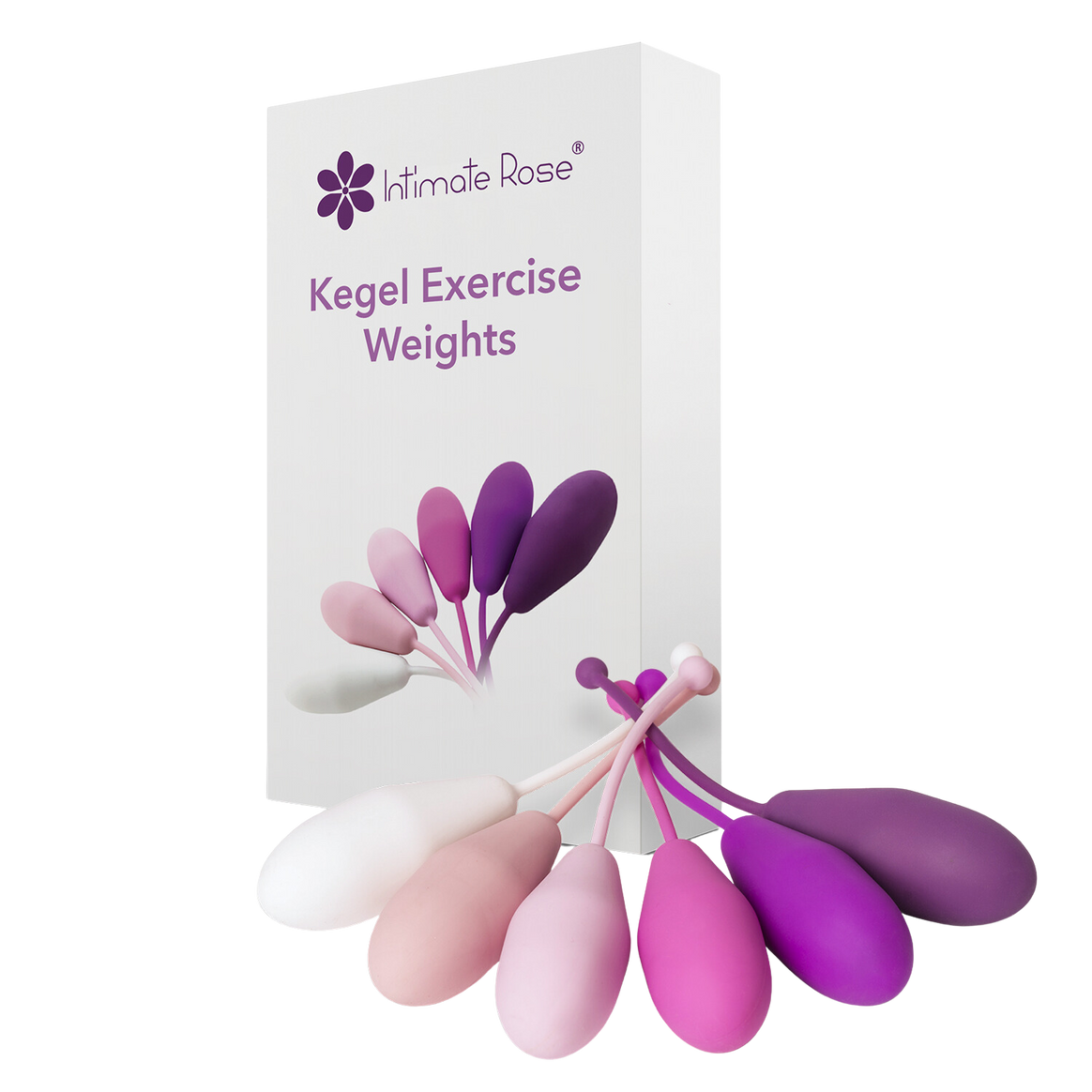The female pelvic floor muscles essentially act as a hammock to support pelvic organs like the bladder, uterus, intestine, and rectum. Weak or underactive pelvic floor muscles can result in side effects that cause discomfort and embarrassment.
Symptoms of weakened muscles can present as bladder or bowel incontinence, discomfort or lack of sensation during intercourse, lower back pain, or pelvic organ prolapse and other forms of pelvic floor dysfunction.
Causes of a weakened pelvic floor can include pregnancy and childbirth, surgery, aging, being overweight, heavy lifting, or coughing excessively.
However, the good news is that it is easy to strengthen the pelvic floor muscles with some regular exercises that any age or body shape can do.
45-Min Online Pelvic Therapy Session, $99 
5 Pelvic Floor Exercises You Can Do At Home
Pelvic floor exercises help build stronger and tighter vaginal muscles for improved bladder control, faster childbirth recovery, and more sexual satisfaction.
1. Squats with Pelvic Floor Activation
Squats help to stretch and strengthen the abdominal and pelvic floor muscles.
- Standing tall, with feet a little wider than hip-distance, turn your heels in slightly and your toes out.
- Place your hands on your hips and take a few breaths to connect with your pelvic floor.
- As you inhale, lower the hips and sit back to squat between your legs, keeping your knees over your ankles as best you can.
- As you exhale, squeeze the muscles in your thighs to support you as you stand back up.
- Repeat for 2-3 sets of 10.
2. Kegels
Kegels are a well-renowned exercise for strengthening the pelvic floor muscles.
However, it is important to perform the minor movements of this exercise correctly. Kegels done incorrectly can do more harm than good.
- Sit up tall, as described above, and take a few breathes to connect with the pelvic floor.
- As you breathe, start imagining your vagina and anus are shutting off the flow of urine, as your pelvic floor muscles lifting gently upward on the exhale.
- As you inhale, release your vagina and anus downward. (Ensure you are relaxing the buttocks and thigh muscles.)
- Repeat for 10 breaths. And work up to 3 sets per day.
For more localized results check out these Intimate Rose Kegel Exercise Weights. There are 6 different weights to help you build strength, and you’ll feel the difference after just 15 minutes a day!
3. Bridge Pose
Bridge pose is a great exercise to tone the glutes, and when done correctly, it also activates the pelvic floor muscles.
- Laying on the floor, with knees bent and feet in line with the hips, allow the length of your spine to relax into the floor.
- Ensure your feet are flat and stay connected to the floor throughout the exercise.
- Straighten the arms along either side of the body with the palms facing down.
- As you inhale, push into your feet, squeeze your thighs and pelvic floor, and lift the hips off the floor. Your body will be supported by your upper back and shoulders.
- Don’t let the hips dip. Your body should form a straight line down to the knee.
- Breathe for 2-3 breaths, and then gently lower your spine to the floor from the upper back down to the lower back.
- Repeat 10-15 times. And work up to 3 sets per day.
4. Split Tabletop
This supine tabletop pose is frequently used in yoga and Pilates to strengthen and stretch the spine, abdominals, and hips. Adding the split movement makes it a perfect exercise to activate the pelvic floor muscles too.
- Begin laying down, with your back flat against the floor. Then bend the knees and keep the lower legs active so they are parallel to the floor.
- Ensure your lower back is connected with the floor by checking that you cannot slip your hand underneath. This will help to activate the abdominals and inner thighs.
- Take a breath with the legs together. Then on the next inhale, begin to slowly open the legs in a controlled movement to the knees open to a comfortable position. (It helps to flex the toes to keep the legs, lower back, and abdominals activated.)
- Use your exhale to slowly bring the legs back together, keeping the lower back flush with the floor and the abdominals strong.
Complete 10-15 times. And work up to 3 sets per day.
5. Bird Dog
Bird Dog is a balance & stability exercise that engages and strengthens the pelvic floor as well as the abdominals and hips.
- Begin on all fours with your wrists under the shoulders and your knees under the hips.
- Flatten your palms into the floor and splay your fingers to find a strong foundation in your hands. Curl the toes under and connect with the balls of the feet for stability in the legs.
- Think about bringing your navel in and up toward your ribs to engage your abdominals. And keep your back straight and your neck long and neutral.
- To start, inhale as you raise & straighten your left leg back and reach your right arm forward.
Keeping the shoulders and hips centered, allow the nose to point toward the floor with the back of the neck long, and hold for 2-3 breaths.
- On an exhale, lower the leg and arm back down.
- On the next inhale, do to same with the right leg and left arm. Hold for 2-3 conscious breaths and release on the exhale.
- Complete a total of 5 on either side. And work up to 3 sets per day.
Kegel Weights

How to Find the Pelvic Floor Muscles
The pelvic floor muscles are located inside the pelvis and extend from the pubic bone to the tailbone, as well from sit bone to sit bone, like a sling or a hammock. Gently touching the space between the vagina and anus while contracting and relaxing the pelvic floor will allow you to feel the pelvic muscles contracting.
Engaging the Pelvic Floor Muscles
Consciously connecting your breath and abdominals with the movement of the pelvic floor during the following exercises will ensure the correct activation and relaxation is achieved.
- To connect with the breath & abdominals, find yourself a comfortable seated position and sit up tall, feeling the spine lengthen, the crown of the head reaching toward the sky, and the chin gently tucked for extra length in the back of the neck.
- Close the eyes and rest one hand gently on the belly with the other on the ribcage.
- Take a few natural breaths and as you inhale allow your belly to grow bigger, feeling your hand moving outward with it, and imagine your pelvic floor dropping downward slightly.
- As you exhale, notice your belly moving inward, feeling your hand moving with it, and imagine your pelvic floor gentle rising back up.
In Closing
Many women of varying ages experience weak pelvic floor muscles causing incontinence, prolapse, or less pleasure during intercourse. However, with some daily pelvic floor exercises, the muscles will gradually strengthen again and life can resume as usual.
Should symptoms persist, or become more painful with time, it is best to consult with a physical therapist specializing in pelvic health to determine a more specific treatment plan.
FAQs
What is the best exercise for the pelvic floor?
Kegel exercises are widely regarded as the best for targeting pelvic floor muscles. By contracting and relaxing these muscles consistently, you can improve bladder control, support pelvic organs, and enhance overall pelvic health.
How can I tighten my pelvic floor fast?
To tighten your pelvic floor quickly, practice Kegel exercises daily by squeezing the muscles you use to stop urine flow. Combine these with diaphragmatic breathing and proper posture for faster results.
How do you know if you are doing pelvic floor exercises correctly?
You’re doing pelvic floor exercises correctly if you feel a gentle lifting sensation in your pelvic area while contracting the muscles used to stop urination. Ensure your thighs and buttocks remain relaxed during the exercise.
What exercises strengthen the pelvic floor?
Exercises like Kegels, bridge pose, squats, and tabletop variations effectively strengthen the pelvic floor. These exercises help improve bladder control, support pelvic organs, and enhance recovery after childbirth.

45-Min Online Pelvic Therapy Session, $99
















